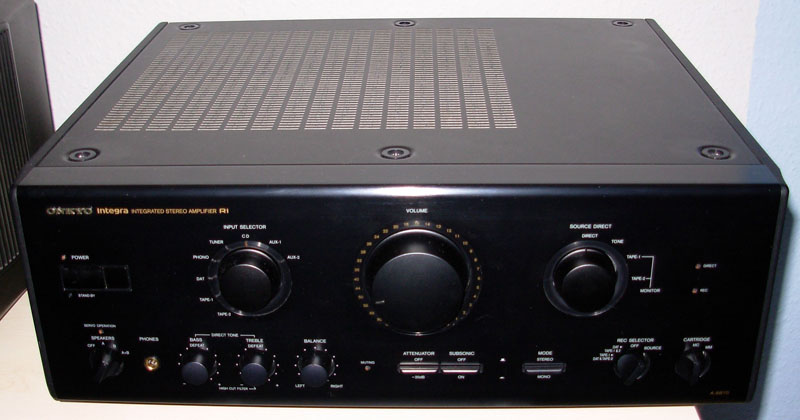Onkyo A-8870
Data
General
- Manufacturer: Onkyo
- Model: A-8870 (identical in construction with Onkyo A-809)
- Years of manufacture: 1992 - 1996 (A-809: 1991-1995)
- Made in: Japan
- Colours: Black, Polar silver
- Type: Integrated amplifier, analogue
- Remote control: Yes (RC 207 S)
- Power consumption: 280 watts
- Dimensions: 455 x 170 x 420 mm (WxHxD)
- Weight: 16,7 kg
- Original price approx.: 1'900 DM
Connections
- Number of inputs: 8
- Phono (MM): 2.5 mV / 50 kΩ
- Phono (MC): 150 µV / 130 Ω
- CD: 150 mV / 30 kΩ
- Tuner: 150 mV / 30 kΩ
- Tape 1: 150 mV / 30 kΩ
- Tape 2: 150 mV / 30 kΩ
DAT: 150 mV / 30 kΩ
- Number of outputs: 3
- Tape 1: 150 mV / 1 kΩ
- Tape 2: 150 mV / 1 kΩ
- DAT: 150 mV / 1 kΩ
Technical Data
- Sine power (at distortion).
- 8 Ohm: 105 Watt (0,008%)
- 4 Ohm: 160 Watt (0,008%)
- Output power
- 8 Ohm: 155 Watt
- 4 Ohm: 235 Watt
- 2 Ohm: 303 Watt
- Total harmonic distortion: 0.008%.
- Attenuation factor: 150 at 8 Ω
- Frequency response: 2 - 50,000 Hz
- Signal-to-noise ratio: 107 dB (CD, AUX).
- Stereo channel separation:
- Tone control: Yes
- Bass: ± 8 dB at 100 Hz
Treble: ± 8 dB at 10 kHz
- Loudness: No
- High Filter: Yes
- Low Filter (Subsonic): Yes
- Mute: Yes
- Direct/Line-Straight: Yes
Special Features
- Servo operated input selector switch
- Very good workmanship, powerful output stages
Remarks
- Other models in the same series:
- Onkyo A-8820
- Onkyo A-8830
- Onkyo A-8850
- Onkyo A-8870
Pictures
- Image: Onkyo A-8870
[[ [[
[[
Reports
- A known malady of this series of Onkyo is a, over time, malfunction of the Input Selector.
- Due to dirt and corrosion within the rotary switch, contact problems are common, resulting in erratic and random jumping around between inputs. However, there is often one or more positions of the rotary switch where the problem occurs less frequently if at all.
- The problem can almost always be eliminated by treating the inside of the rotary switch with contact spray, or better yet, mechanically cleaning the contact surfaces beforehand. A recurrence of the problem after a certain time frame, which can range from hours to years, cannot be ruled out.
When using Contact Spray 60, you should always rinse afterwards (e.g. with Contact WL), as Contact 60 attacks non-ferrous metals!
- Competitors : Onkyo A-8780, Onkyo A-8870, Pioneer A-702 R, Yamaha AX-890, Sony TA-F 690 ES, Denon PMA-1080 R, Denon PMA-1315 R
